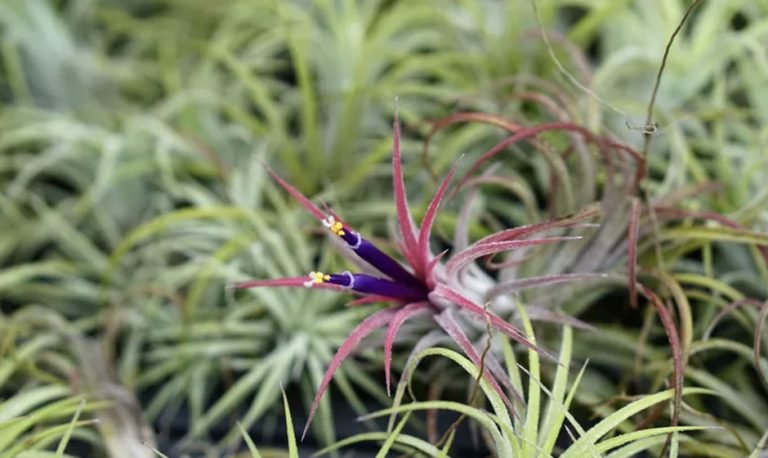Introduction
Air plants, also known as sky plants, are a captivating addition to any indoor plant collection. Among the vast array of air plant species, Tillandsia ionantha stands out as one of the most popular and visually striking varieties. With over 500 different types of Tillandsia to explore, sky plants are known for their resilience, adaptability, and minimal maintenance requirements, making them an ideal choice for beginners and experienced plant enthusiasts alike.
Aesthetics and Growth
Sky plants start their journey as tiny plants with clusters of green and gray leaves, forming a delightful round shape. As they mature, their foliage elongates, and their colors deepen, creating an exquisite wavy form. One remarkable characteristic of Tillandsia ionantha is that it blooms only once, right before its demise. This bloom phase, which can occur at any time of the year, reveals small, stunning yellow or white flowers atop striking purple-toned shoots. Additionally, the leaves develop captivating pink or reddish hues during this period, adding to the overall charm of these plants.
Cultivation and Placement
Tillandsia ionantha, like all air plants, does not require a traditional potting medium. It is an epiphytic species that naturally grows on other plants or tree branches. When cultivating sky plants, consider unique placement options such as mounting them on untreated wood pieces, displaying them in glass terrariums, or even tucking them into shells. Some enthusiasts use specialized wireframes to suspend the plants, adding an artistic touch to their indoor spaces.
Sky Plant Care
While Tillandsia ionantha is relatively hardy, it still requires specific care to thrive. Here are some essential care tips for sky plants:
Light Requirements
Providing adequate lighting is crucial for air plant health. Sky plants thrive in indirect light, making them suitable for spaces with fluorescent lighting, such as offices. However, be cautious about exposing them to strong, full sun, as it can cause dehydration and leaf scorching, particularly in low-humidity environments.
Soil and Watering
As the name suggests, air plants grow in the air and do not require soil for their root systems. Instead, they rely on light misting to fulfill their water needs. Sky plants prefer warm and humid conditions but should not be overwatered. Lightly mist them a few times a week, adjusting the frequency based on your climate. In drier regions, you can also rinse the plants under a tap, ensuring excess water is shaken off and allowing them to dry completely before repositioning.
Temperature and Humidity
Tillandsia ionantha thrives in warm, tropical-like environments with temperatures between 60 and 80 degrees Fahrenheit. However, they can adapt well to dry heat if provided with regular mistings. During the winter, exposing them to slightly cooler temperatures can promote flowering in the following year. Good air circulation is essential for the health and vitality of these plants.
Fertilizing
Air plants benefit from occasional fertilization, particularly during the summer months. Consider using fertilizers specifically formulated for air plants, or try organic options such as fish emulsion mixed with your misting spray. Feed your sky plants once or twice a month to enhance their growth and overall health.
Varieties and Propagation
Tillandsia ionantha encompasses a range of captivating varieties, each with its unique features:
- ‘Feugo’: This variety boasts deep red foliage, which intensifies with ample sunlight.
- ‘Rubra’: Despite its compact size, ‘Rubra’ exhibits spreading growth, creating a visually appealing wide form.
‘Maxima’: Known for its larger size, ‘Maxima’ can withstand more direct sunlight and is perfect for those seeking a statement piece in their plant collection.
One of the fascinating aspects of sky plants is their ability to propagate through offshoots, often referred to as “pups.” As Tillandsia ionantha matures, it produces these pups, which can be cut off once they reach approximately half the size of the parent plant. By propagating these pups, you can extend your enjoyment of Tillandsia ionantha for several years to come.
In conclusion, growing and caring for sky plants, particularly Tillandsia ionantha, adds a touch of natural beauty to any indoor space. With their remarkable resilience, striking appearance, and minimal maintenance requirements, these air plants are a captivating addition to any plant enthusiast’s collection. Embrace the enchanting world of sky plants and create a unique, visually stunning display in your home or office.
Note: All information provided in this article is based on general guidelines for growing sky plants. It’s important to research the specific care requirements for the variety of Tillandsia ionantha you have, as well as consider your local climate and environmental conditions.


